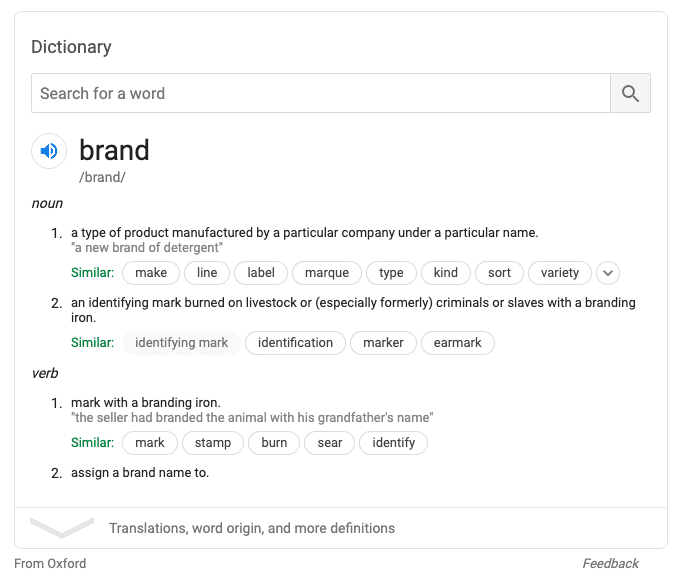Brands are more than logos.

by Nick Kastner, director of brand and digital strategy
One of the biggest and most impactful things any organization has is its brand. And, its often misunderstood. Even the dictionary doesn’t understand brand.
In a quick Google search, you can find the definition of a brand from the Oxford dictionary as the following:

So, it’s no surprise when we met with clients that they immediately say “oh, you mean the logo.” Actually, no. That’s not it at all. It isn’t just the logo – or mark – that dictates who you are. And it’s not the products or services the company offers.
You really can’t hold or hear or touch or even necessarily “see” a brand. It’s something that’s intangible but it defines who or what you are.
It’s really just the perception of your company. But most importantly, it isn’t your perception but the consumers’.
Branding expert Marty Neumeier says “It’s [brands] not what you say it is. It’s what they say it is.” So when you think about a company like Chick-Fil-A, do you immediately think chicken sandwich and customer service? Maybe their faith and lemonade? Me too! So, that’s what Chick-Fil-A is. It’s not necessarily about cow commercials and a logo with a C and a chicken drawn in it. That’s part of it – but that’s not their actual “brand.” It’s how we as consumers perceive what they offer.
And, there are lots of pieces to the brand puzzle. It includes:
- Your organization’s mission and vision
- Your organization’s values
- Your leadership and staff
- Your customers
- Your customer service efforts
- Company culture
- Brand architecture (that’s the visual stuff – colors, symbols, names – the “visual language)
- Brand names, identity elements, taglines and logos are also included
- Branded language, voice and phrasing
- Websites
- Social media channels
- Other marketing efforts
- Etc.
Research shows that ALL of these elements influence the perception of the organization – or the brand. Plus, so does that team member who works at the register or the person who answers the phone. All of these impact the brand.
So Why Do I Care about Branding?
Well, believe it or not, while these elements don’t typically show you a direct return on your investment (unless you’re a huge organization), they do directly influence return on investment.
Well-branded organizations have more effective marketing efforts – because they’re more recognizable – they can sell more because the consumer understands what the brand offers and you can create additional value for you and the consumer.
As marketers, we can work to influence the perception of a brand. Now, marketing can’t influence the staff member providing bad customer service to your customers – or even a prior bad experience – but we can work to create new meaning around an organization. Remember that people want simple, clear messages – and that whatever perception is created, well, perception is reality for many. And branding has the power to shape reality.
The First Step
The first step for most organizations is to understand “who” they are. If someone were to ask you “who is [insert your organization’s name here]?,” do you immediately spout off the products or services you offer, or is your organization more than that? In meeting with clients, one of the most difficult questions we ask is just that – and many sit and look at us and say “um, that’s a really tough question.” However, if you have an established brand, that answer gets easier. Ask someone from Coca-Cola® and they’ll tell you something regarding happiness or bringing smiles and happiness to the world. That’s a big vision, but that’s who they are.
Over the past several months, we’ve been working with clients in this space – leaning specifically into brand theory and Jungian archetypes – and helping them move to the next level. And, in the process, it’s helped us and our clients better understand who they are, who their customers are, and make really good marketing decisions.
Many of you will be taking a few days off during the holidays. During that break, I’d encourage you to ask yourself – who is my company? Answering that question – and living it day in and day out – is just one part of your strategy. If you need help, give us a call.
Back